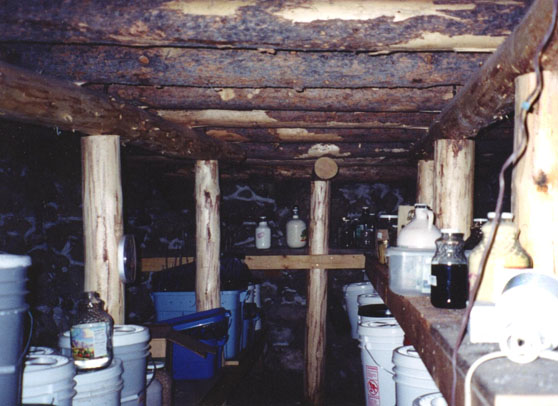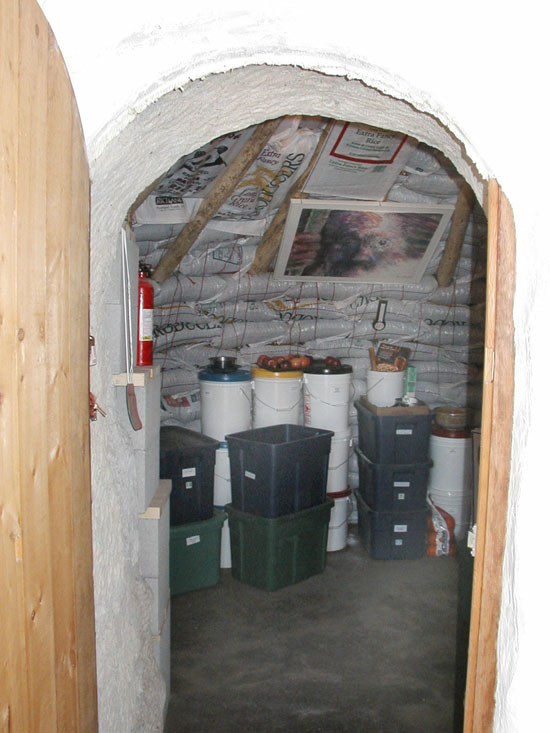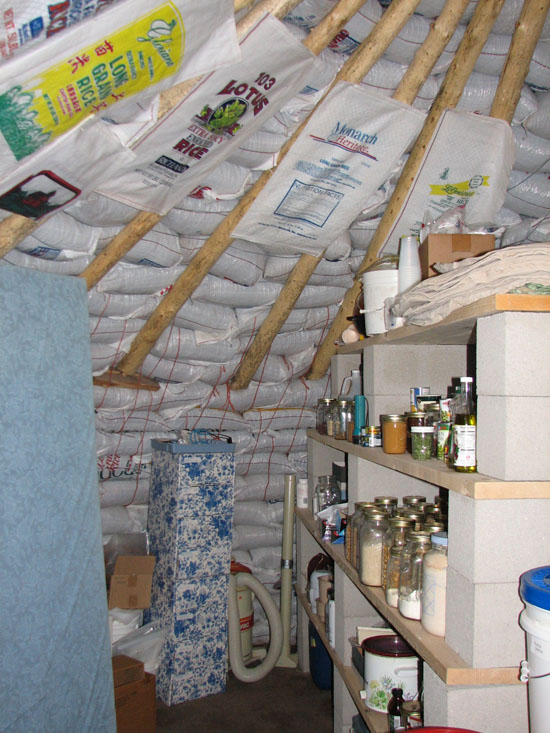In this age of electric refrigeration, the use of cool storage pantries and root cellars has all but faded into oblivion. This is unfortunate, since they have great value for many reasons. There is only so much that can be put into a refrigerator, and the bigger the fridge, the more it costs to keep it cool. With pantries and root cellars, the storage potential is much greater and the cool atmosphere is free and non-polluting.
There is a distinction between a root cellar and a cool pantry: humidity. A true root cellar should be kept fairly moist in order to best preserve the crops that are stored there, whereas a pantry needs to be much dryer to avoid spoilage. Root cellars are limited in their use, but a pantry can store practically anything.
Before the days of refrigeration, root cellars and ice boxes were about the only way to keep certain crops fresh after harvest. Root cellars were usually separate from the house and dug into the ground to take advantage of the cool, stable temperature beneath the surface.
Depending on how often the produce needs to be accessed, there are differing strategies for creating the space. The simplest concept is to just bury a garbage can in the ground, with the lid protruding above, then digging a trench around the can so that straw can be thrown on top and then plastic sheeting placed over it all with rocks to hold it down. Damp burlap or sand can be enclosed with the produce to maintain the proper humidity. Obviously it takes some work to get at the produce, but this method will store some items, especially over the winter.
A more elaborate and convenient root cellar will have a door for entry, sometimes placed flat on the ground or at an angle, but probably the best arrangement is with a vertical, insulated door. If the root cellar itself is completely underground (which it really needs to be to take advantage of the cool earth), then there would be steps that descend to the door, or a covered entrance with steps after the door. Another possibility is digging into a hillside. Depending on the stability of the soil, the sides of the excavation might either be left unfinished or lined with materials to create a retaining wall. The roof needs to be supported by some fairly massive timbers to support up to two feet of dirt placed on top. Care should be taken to avoid contact between the dirt and any wood used. Sheets of heavy polyethylene can be used to good advantage to protect the wood. Usually if the floor is left as natural earth, or just has a layer of gravel on it, the humidity will remain high enough to store most produce.
It is a good idea to provide some ventilation, with a high outlet vent and a low inlet vent. These could be closed during really cold spells to assure that nothing freezes, but having some air movement keeps the space fresh and allows off-gassing of the produce to occur without harm. Apples will give off ethylene gas which can cause potatoes to sprout prematurely and make carrots go bitter, so store the apples near the outlet vent.
If you keep a thermometer/humidity gauge in the root cellar you can monitor the space for optimal conditions, and make adjustments as needed for what you are storing. Vegetables that like to be cold and very moist (32-40 degrees F., 90-95% humidity) include: carrots, beets, celery, Chinese cabbage, kohlrabi, Brussels sprouts, rutabagas, turnips, collards, broccoli and Jerusalem artichokes. Produce that likes to be kept cold and fairly moist (32-40 degrees F., 80-90% humidity) include: potatoes, cabbage, cauliflower, apples, grapes, oranges, pears and grapefruit. Produce that likes to be kept cool and fairly moist (40-45 degrees F., 85-90% humidity) include: cucumbers, sweet peppers, cantaloupe, watermelon, eggplant and ripe tomatoes. Vegetables that prefer cool and dry conditions (35-40 degrees F., 60-70% humidity) include garlic and onions. Produce that likes to be stored in fairly warm, dry conditions (50-60 degrees F., 60-70% humidity) include: dry hot peppers, pumpkins, winter squash, sweet potatoes and green tomatoes.
Unless you have an abundance of the produce mentioned above, a root cellar may not be so useful for you. On the other hand, a cool pantry would be useful for almost anybody. We built one as an extension of our house and would feel deprived without it. We decided to make a rather large one (about 100 square feet), and I’m really glad we did. This allows us to keep lots of staples on hand, which diminishes our need to make that trip out to stock up on food, and it’s a great feeling to know that we could survive all manner of problems and help our neighbors as well.
Our pantry is situated right next to our kitchen, which makes it especially useful. Most food items will last much longer if kept cool and dry, so we have grains, beans, nuts, dried produce, dry milk, canned goods, pet food, wine, etc., much of it in 5-gallon containers. There is lots of room in there to store empty bottles and miscellaneous kitchen wares that we don’t need frequently. We don’t have a separate root cellar, so we also store fruit, potatoes, garlic and onions, yams and squash in there. These items definitely last much longer than they would at room temperature in our kitchen.
This pantry is dug about five feet into the ground on the north side of our house. It is semi-circular in shape, with sloping walls made of polypropylene bags filled with sand at the lower level and crushed volcanic rock above that. The conical roof is partially supported with a pole framework because the pitch is too shallow for the bags to be self-supporting. The whole thing is just covered with several layers of plastic sheeting and then covered entirely with dirt. There is an inlet air vent on one side and an outlet vent at the very top. The floor is adobe poured over plastic sheeting, so the atmosphere is fairly dry. After quite a few afternoon rains, the humidity in there is only 64%. It has never leaked. The temperature ranges from a low of about 36 degrees F. (in the dead of winter) to a high of about 65 degrees F. in the heat of the summer. If it were dug deeper into the ground this spread would be less.
Another interesting approach to building a pantry is to bury a section of a large culvert pipe. One man took an eight feet diameter by fifty feet long culvert, welded the ends closed, and created a hatch for entry. The air vents and entry were camouflaged, so he had a secret hideaway/storage unit. This same concept could provide a completely buried pantry that is accessible from inside a house.
Many house designs would not easily accommodate a buried pantry. Another strategy for keeping a room cool is to locate it on the north side of the house, and have substantial air vents that are opened only at night during the warmer seasons. This requires a little more attention to maintain a cool temperature, but makes it possible to retrofit an existing house with a nice cool pantry. The room should be well insulated to keep it from warming up too much during the day.
The idea of having a large cool storage room next to the kitchen makes so much sense to me that I think all houses should be designed this way. This facility uses no energy to keep things cool and promotes a lifestyle of fewer miles driven, along with a feeling of abundance and security. What a winning combination!

i bought a cabin that used to be a small log cabin with a dirt basement dug by hand. The cabin was built on log beams and the dirt walls were simply framed with pallet like materials.There are no windows in the basement and someone added rooms on left side of cabin and added a back door with a landing and stairs going downstairs while still having flat cellar door outside. The original man was a moose butcher for the town and used basement as cellar in the 1930s. I think he added to the house and made it into a basement and put a woodstove then a electric furnace hanging from underneath with a grate through the floor. Its hard to keep basement fresh and i need ideas to frame walls in basement because the floor is like a concrete (mining shotcrete) . Any ideas. i could send you pictures.
You could line the walls with earthbags. It sounds like the space needs some form of ventilation.
…wine, etc., much of it in 5 gallon containers…
:)
I love this. We are hoping to include a cool pantry in our off-grid retirement house in the high NM desert, on the north side off of the kitchen. I wonder if it would make sense to combine the techniques, to have a couple of bins buried into the floor of this partially below-grade pantry, which we could fill with damp sand for our root vegetables…
Do you just keep your root vegetables in bins in your pantry? Do you store them in damp sand, or what?
I also wonder about how you balance thermal mass and the pantry… we hope to build a tire bale house, with the most substantial tire insulation/mudded thermal mass walls at the back of the house, and a berm behind that. Would we want less thermal mass/insulation at the pantry?
One design we considered would be to have a tire bale wall at the back but with a break in the wall for the pantry, with the roof supported by a header beam spanning the opening in the tire-bale wall. Then we would use double earthbag walls to enclose the back of the pantry so it is less insulated from the berm. Then maybe scoria earthbags at the front, separating the pantry from the kitchen, so it would be more insulated from the warmer kitchen?
We’re thinking the pantry would be a couple steps down from the kitchen.
I would love to hear your (or others’) advice, since you are so experienced and we are ignorant newbies who are just doing as much booklearnin’ as possible before digging in…
I see no reason why a buried bin within the pantry wouldn’t work out well. I have heard that keeping root vegetables buried in damp sand works very well, but I haven’t tried it myself. In the New Mexico desert the underground temperature hoovers around 60 degrees F., so that is the temperature you could expect much of the year in a mostly buried pantry; this would be true regardless of how much mass is in the pantry. I suggest that the pantry is well insulated from the rest of the house. This is a fine temperature for many things, but a little warm for other things; about the only passive thing you can do about that is to vent colder air in the space during the winter.